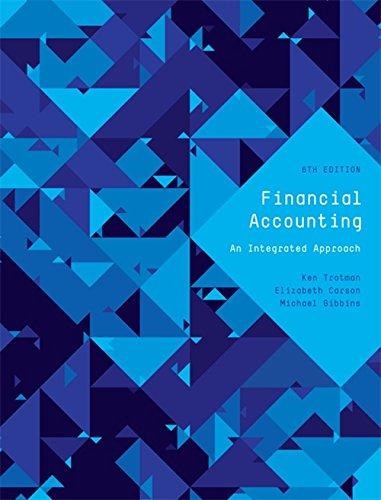A company stops accumulating costs (capitalising) in a long-term asset account (such as a building asset), and
Question:
A company stops accumulating costs (capitalising) in a long-term asset account (such as a building asset), and begins charging expenditures to expense and calculating depreciation expense on the asset when the asset is put into service and begins to earn revenue. This is usually fairly straightforward, but consider the following.
The company owns an office building that is scheduled to be completely finished on 1 September 2016. As of 1 July 2016, construction costs totalled $3 million, including interest on construction financing of $150000 ($10000 from 1 April 2016 to 1 July 2016). The first tenant moved in on 1 April 2016 and was followed by several others. At 1 July 2016, approximately 40 per cent of the space had been rented. Projections indicate that 70 per cent of the office space needs to be rented before the building will be profitable. Unfortunately, the vacancy rate is extremely high for office space in this area of the city because of a recent economic downturn. Average occupancy is 60 percent in other office buildings nearby, with no expectation of improvement for at least three years. To date, rent of $50000 has been paid by the tenants, in addition to expenses amounting to $10 000 to reimburse the company for some of the utilities, cleaning and other common-area costs of the building that total $25 000 from 1 April to 1 July 2016. The rental revenue, common-area costs and common-area cost reimbursements have been netted and capitalised, reducing construction costs to date by $35 000 in total ($50 000 + $10 000 — $25000). Moreover, the construction costs to date include $100000 paid to these tenants by the company to cover some of their leasehold improvements (alterations the tenants had to make to their office space to make it suitable for their use, such as interior walls, painting and floor coverings). These payments to the tenants were inducements to lure them away from their old premises in other nearby buildings and into signing long-term rental agreements (five years) with the company.
1. Is the company correct in capitalising some or all of the above items? Why or why not?
2. When might be an appropriate time to record cash receipts and disbursements related strictly to rental activity as income statement items, rather than balance sheet items (i.e. to recognise revenues and expenses)?
Step by Step Answer:

Financial Accounting An Integrated Approach
ISBN: 9780170349680
6th Edition
Authors: Ken Trotman, Michael Gibbins, Elizabeth Carson





